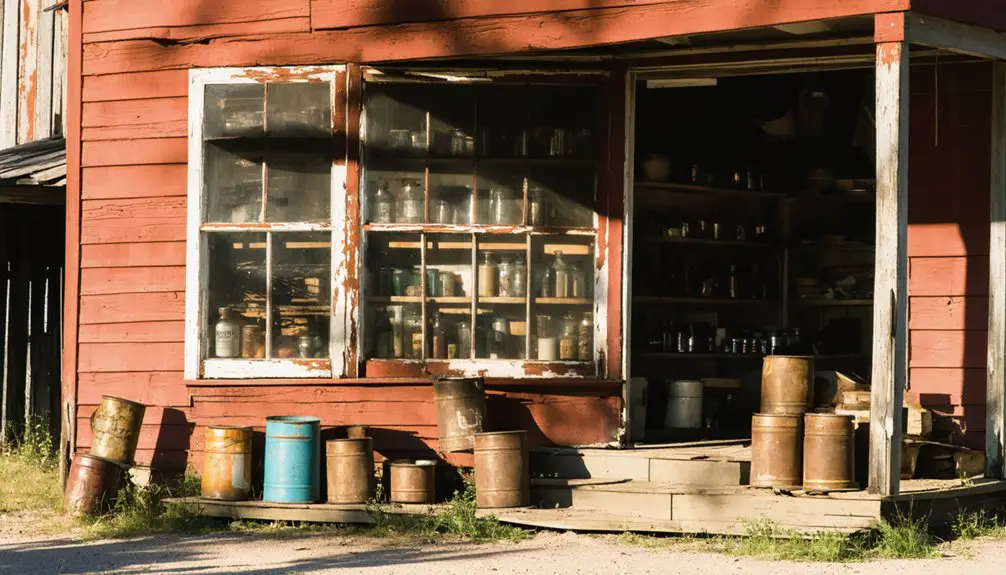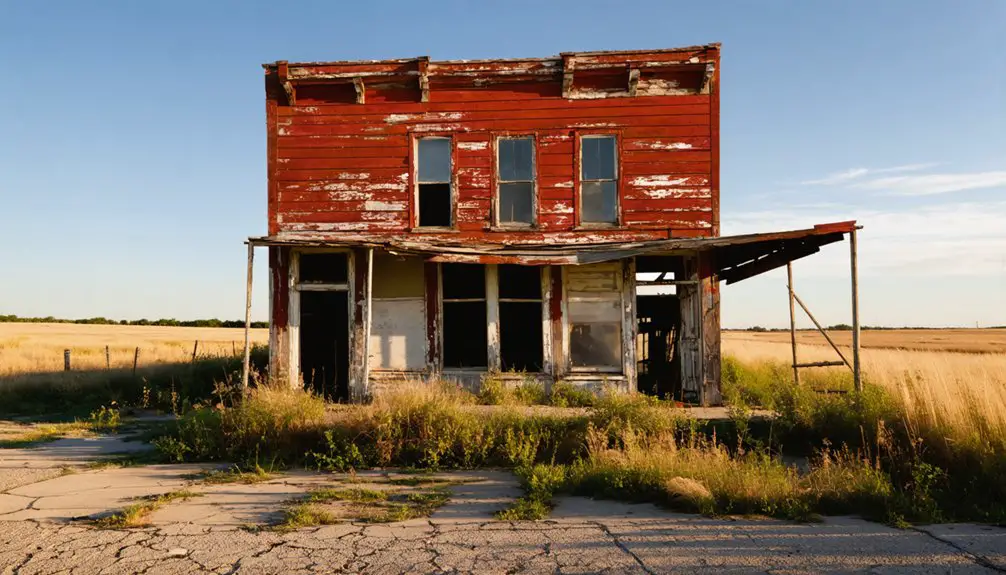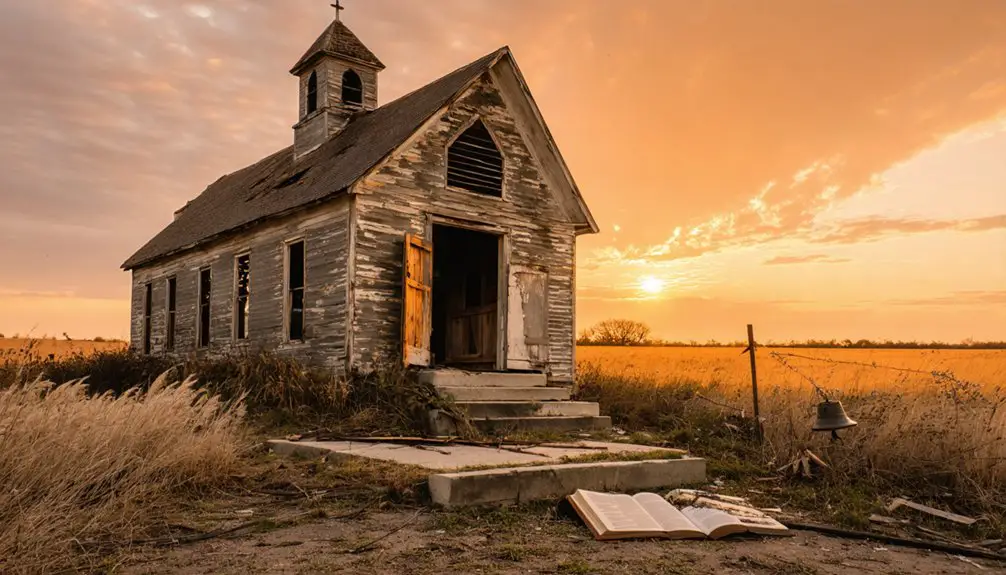You’ll find Warwick, Oklahoma at the crossroads of railroad and Route 66 history. This former boomtown emerged in 1896 when the St. Louis & San Francisco Railway established operations, later flourishing with the addition of Route 66 in 1926. While the town’s population has dwindled to around 150 residents after being bypassed by modern highways, notable landmarks like the historic Seaba Station Motorcycle Museum preserve its rich transportation heritage.
Key Takeaways
- Warwick became Oklahoma’s first town entirely bypassed by Route 66’s 1928 realignment, contributing to its decline toward ghost town status.
- The town’s economic decline accelerated after the abandonment of its railroad depot and construction of Interstate 44.
- Despite being considered a ghost town, Warwick maintains a small population of 100-150 residents and basic infrastructure.
- Seaba Station Motorcycle Museum, formerly Seaba’s Filling Station (built 1921), remains a preserved landmark from the town’s prosperous era.
- The town emerged during the 1890s railroad boom but lost its commercial significance after transportation routes changed.
From Tribal Lands to Territory Settlement
Before Oklahoma Territory opened to non-Native settlement, the region’s land belonged to various indigenous tribes including the Iowa, Sac & Fox, Citizen Potawatomi, and Absentee Shawnee. These tribes maintained tribal sovereignty over their territories through communal and individual land ownership, protected by treaty rights.
Similar to how the Minsi land rights were claimed without proper understanding, tribes watched as colonial land speculators began eyeing their territories. You’ll find that everything changed with the implementation of the Dawes Act, which forced the subdivision of tribal lands into 160-acre parcels for Native American families. This federal policy of land dispossession deliberately undermined traditional tribal governance and communal land-holding practices.
When the 1889 and 1891 land runs began, over 20,000 settlers rushed to stake claims, overwhelming Native territories. The Trail of Death in 1838 had already forced the Potawatomi from their ancestral lands before these runs. Within a single day, tribes watched helplessly as their reserved lands transformed into settler homesteads, setting the stage for Oklahoma’s eventual statehood.
The Birth of a Railroad Town
You’ll find Warwick’s transformation into a railroad town began in 1896 when the St. Louis & San Francisco Railway acquired right-of-way from settler David Hugh.
The town’s strategic location attracted a second railroad, the Fort Smith & Western Railway Company, in 1903, establishing Warwick as an essential transportation hub. The town was formally developed when town lots platted created organized plots for further growth. Located at an elevation of 876 feet, Warwick offered an ideal setting for railway operations.
Early businesses quickly sprouted around the railways, including grocery stores, filling stations, hotels, and agricultural services that formed the foundation of Warwick’s economy.
Railroad Brings Economic Growth
When the St. Louis & San Francisco Railway arrived in Warwick in 1896, you’d have witnessed the dawn of unprecedented economic prosperity.
Railroad expansion transformed this modest settlement into a bustling hub of commerce, attracting entrepreneurs who established grocery stores, filling stations, hotels, and a cotton gin.
The town’s economic diversification accelerated as banks and newspapers emerged, while specialized services like blacksmiths, sawmills, and veterinarians set up shop to serve the growing population.
You’d have seen local farmers finally connecting their produce to broader markets through efficient rail transport. Like the original Warwick Railroad, which cost $200,000 to build, this rail line represented a significant investment in the region’s future.
The railroad’s presence even funded the construction and expansion of schools, as more families chose to settle in this well-connected community.
Warwick’s strategic position along these new transportation routes made it an essential stop in Oklahoma’s commercial network. The Frisco Railway Company played a crucial role in developing branch lines throughout Oklahoma during the late 1880s, connecting smaller communities to major trade centers.
Early Transportation Hub Forms
As David and Norah High staked their homestead claim in 1891, they laid the foundation for what would become an essential transportation nexus in Oklahoma Territory.
You’ll find Warwick’s transportation evolution began with sluggish stagecoach limitations, taking a full day to cover just 50 miles to Guthrie. By 1896, the region’s potential caught the attention of major railways, transforming the settlement into a bustling hub when the St. Louis & San Francisco Railway built its line through High’s land.
- Two major railways converged at Warwick by 1903
- A five-bay brick station showcased modern architectural design
- Daily stagecoach routes gave way to efficient rail service
- Strategic location attracted both passengers and freight traffic
- The Fort Smith & Western Railway’s eastern route expanded regional connections
Boom Years Along Route 66
The 1926 designation of Route 66 through Warwick transformed this quiet agricultural settlement into a thriving commercial hub.
You’d have found multiple filling stations, grocery stores, and hotels springing up to serve the surge of highway travelers. The road’s presence amplified the economic impact of the town’s two railroads, creating unprecedented commercial opportunities.
Local businesses seized the moment, with cotton gins, blacksmith shops, and banks expanding their operations to meet growing demands. The town’s cotton and grain production remained the backbone of its economy.
Seaba’s Filling Station, built in 1921, became a landmark stop for travelers, complete with cast iron toilets and modern amenities. The station was one of many historic filling stations that contributed to Oklahoma’s Route 66 character.
The 1928 road realignments optimized travel routes, while distinctive brick and concrete block buildings rose alongside the highway, cementing Warwick’s position as an essential Route 66 stop.
Legacy of Seaba Station
Standing as a tribute to early automotive culture, Seaba Station transformed from a humble 1921 filling station into a celebrated motorcycle museum that draws visitors worldwide.
Through historic preservation efforts, this architectural gem maintains its original polychrome brick design, geometric patterns, and unique five-sided service bay structure. Originally serving Nevmox gasoline to motorists, this DX service station later evolved with the changing times. The station’s Save-a-Landmark recognition helped ensure its preservation for future generations. You’ll find over 125 vintage motorcycles housed within its walls, including rare specimens still in their original delivery crates.
- Experience the thrill of seeing motorcycles from different eras, including the movie-famous “Hydra” bike
- Explore the historic rock-built outhouse featuring early gender-segregated restrooms
- Visit without paying admission fees, though donations support preservation
- Join weekend rides and motorcycle events that keep the spirit of Route 66 alive
- Discover the station’s role in early highway travel before and after Route 66’s designation
Agricultural Heritage and Commerce

Beyond the automotive history of Seaba Station lies Warwick’s deep-rooted agricultural foundation, which began in 1891 when David and Norah High established their homestead during the Oklahoma Land Run.
You’ll find that cotton dominated the landscape as the primary cash crop, supported by innovative agricultural sustainability measures including a local cotton gin, blacksmith shop, and veterinary services.
The town’s agricultural commerce flourished through rural innovation and strategic transportation networks.
Two railways – the St. Louis & San Francisco and the Fort Smith & Western – enabled efficient crop distribution, while Route 66 brought additional trade opportunities.
Local businesses, including multiple grocery stores, hotels, and a bank, served the farming community’s needs.
However, when newer highways bypassed the town and the railroad depot closed, Warwick’s agricultural economy gradually declined into ghost town status.
Transportation’s Impact on Town Destiny
While two major railways initially secured Warwick’s promising future in 1896, the town’s destiny would ultimately hinge on shifting transportation patterns over the next century.
You’ll see how transportation evolution both built and dismantled this Oklahoma settlement, as changing routes reshaped its economic resilience. The railways first empowered Warwick’s growth, but subsequent highway realignments proved devastating.
- St. Louis & San Francisco Railway’s 1896 arrival sparked the town’s establishment
- Route 66’s original alignment brought prosperity through filling stations and hotels
- Warwick became the first town entirely bypassed by Route 66’s 1928 realignment
- The railroad depot’s abandonment further accelerated economic decline
- Interstate 44’s construction dealt the final blow, solidifying Warwick’s ghost town status
Life in Early Warwick

When David and Norah High claimed their homestead during the 1891 Oklahoma Land Run, they laid the foundation for what would become Warwick’s vibrant early community.
You’d have found a bustling town where cotton farming drove the local economy, with ginning facilities and a sawmill supporting the agricultural backbone.
Community gatherings centered around a log building that served dual purposes as both church and school until 1909, when a solid block structure took over early education duties.
The town boasted essential businesses like grocery stores, hotels, blacksmith shops, and even a bank.
Your daily life would’ve revolved around agricultural rhythms, while saloons, drug stores, and a local newspaper provided social connections and necessary services in this frontier settlement.
Modern Day Ghost Town Reality
Despite its historical decline, Warwick’s current status challenges traditional ghost town classifications. With 100-150 residents and functioning establishments like the Seaba Station Motorcycle Museum, it’s more accurately described as one of Oklahoma’s semi-abandoned communities rather than a true ghost town.
Warwick defies ghost town labels, sustaining a modest population and vibrant landmarks that keep its community spirit alive.
You’ll find maintained infrastructure and active community spaces that set it apart from the state’s 2,000+ ghost towns where complete abandonment has taken hold.
- Active church and motorcycle museum indicate ongoing community importance
- Population decline hasn’t led to complete desertion or structural decay
- Basic public functions continue to operate
- Buildings remain well-maintained, unlike typical ghost town ruins
- Current status aligns with “historic community” classification rather than abandonment
Preserving Historical Landmarks

The preservation of Warwick’s historical landmarks operates within Oklahoma’s robust legal framework for protecting cultural heritage sites.
You’ll find these efforts guided by the State Historic Preservation Office‘s extensive plan, “Tomorrow’s Legacy,” which guarantees systematic protection of ghost towns like Warwick.
Community involvement plays a crucial role in historic preservation through public nominations and grassroots advocacy.
You can participate in annual surveys and discussions that help identify endangered sites and prioritize preservation needs.
Environmental challenges often complicate these preservation efforts, especially in areas with industrial histories.
If you’re interested in supporting Warwick’s preservation, you’ll find various funding opportunities through public grants and private donations.
The Historic Preservation Committee works alongside local communities to secure resources and implement protection strategies that safeguard these irreplaceable landmarks for future generations.
Warwick’s Place in Oklahoma’s Past
Nestled at the crossroads of two major railways, Warwick emerged as a thriving agricultural community after David and Norah High’s initial homestead in 1891.
The town’s cultural heritage reflects Oklahoma’s transformation from frontier territory to vibrant state, witnessing dramatic economic shifts through transportation evolution – from stagecoach to railroad to Route 66.
- You’ll find Warwick’s roots in its English namesake, meaning “dwellings by the weir”
- Your journey through time reveals Warwick’s role as an essential agricultural hub with diverse businesses
- You can trace the town’s prosperity through its strategic location at railway intersections
- You’ll discover how Seaba’s Station became a National Register landmark
- You’re witnessing living history as Warwick maintains a small but resilient population, defying complete ghost town status
Frequently Asked Questions
What Was the Highest Recorded Population of Warwick During Its Peak?
Like a fading photograph, you’ll find no official peak population records exist, though the historical significance of multiple businesses and services suggests several hundred residents before population decline began.
Are There Any Remaining Original Buildings Besides Seaba Station?
You’ll find almost no intact original structures beyond Seaba Station. Only a ruined gas station remains partially standing, while historic preservation efforts haven’t saved any other early buildings from complete deterioration.
When Was the Last Time Passenger Trains Stopped in Warwick?
You’ll find the last passenger train stopped in Warwick on April 19, 1968, when the depot closed. This marked the end of regular railway history and passenger service in the community.
What Native American Artifacts Have Been Found in the Warwick Area?
You’ll find an array of Native tools including flint projectile points, stone scrapers, and Clear Fork gouges at Historic sites near Warwick, along with Chickasaw pottery sherds and trade-era European goods.
Did Any Notable Outlaws or Historical Figures Pass Through Warwick?
If you’re hoping to find outlaw legends in Warwick’s history, you’ll be disappointed. Despite its location near infamous shootout sites like Ingalls, no notable historical figures are documented passing through Warwick.
References
- https://www.legendsofamerica.com/ok-warwick/
- https://en.wikipedia.org/wiki/List_of_ghost_towns_in_Oklahoma
- https://www.theroute-66.com/warwick.html
- https://www.legendsofamerica.com/66-ghosttowns/
- https://wanderwisdom.com/Ghost-Towns-of-Route-66
- http://www.albertwisnerlibrary.org/Factsandhistory/History/Shorthistory.htm
- https://www.potawatomi.org/blog/2020/11/18/native-land-rights-and-the-land-runs-of-1891/
- https://www.census.gov/about/history/stories/monthly/2024/april-2024.html
- https://stlukesmuseum.org/edu-blog/the-warraskoyack-a-brief-history/
- https://guides.loc.gov/native-american-spaces/cartographic-resources/indian-territory



